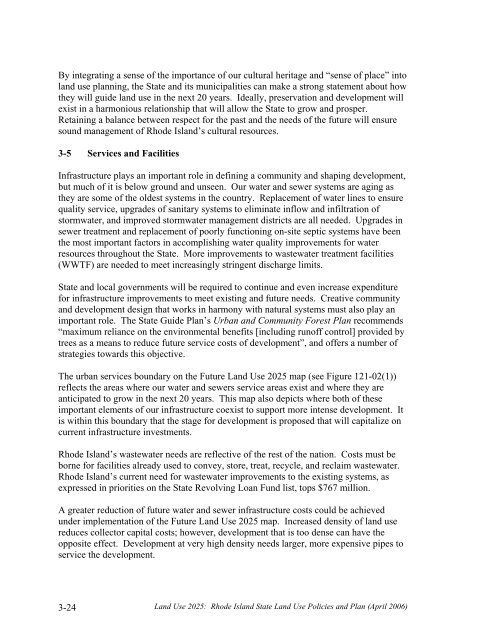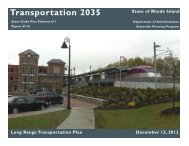Land Use 2025 - RhodeMap RI
Land Use 2025 - RhodeMap RI
Land Use 2025 - RhodeMap RI
- No tags were found...
Create successful ePaper yourself
Turn your PDF publications into a flip-book with our unique Google optimized e-Paper software.
By integrating a sense of the importance of our cultural heritage and “sense of place” intoland use planning, the State and its municipalities can make a strong statement about howthey will guide land use in the next 20 years. Ideally, preservation and development willexist in a harmonious relationship that will allow the State to grow and prosper.Retaining a balance between respect for the past and the needs of the future will ensuresound management of Rhode Island’s cultural resources.3-5 Services and FacilitiesInfrastructure plays an important role in defining a community and shaping development,but much of it is below ground and unseen. Our water and sewer systems are aging asthey are some of the oldest systems in the country. Replacement of water lines to ensurequality service, upgrades of sanitary systems to eliminate inflow and infiltration ofstormwater, and improved stormwater management districts are all needed. Upgrades insewer treatment and replacement of poorly functioning on-site septic systems have beenthe most important factors in accomplishing water quality improvements for waterresources throughout the State. More improvements to wastewater treatment facilities(WWTF) are needed to meet increasingly stringent discharge limits.State and local governments will be required to continue and even increase expenditurefor infrastructure improvements to meet existing and future needs. Creative communityand development design that works in harmony with natural systems must also play animportant role. The State Guide Plan’s Urban and Community Forest Plan recommends“maximum reliance on the environmental benefits [including runoff control] provided bytrees as a means to reduce future service costs of development”, and offers a number ofstrategies towards this objective.The urban services boundary on the Future <strong>Land</strong> <strong>Use</strong> <strong>2025</strong> map (see Figure 121-02(1))reflects the areas where our water and sewers service areas exist and where they areanticipated to grow in the next 20 years. This map also depicts where both of theseimportant elements of our infrastructure coexist to support more intense development. Itis within this boundary that the stage for development is proposed that will capitalize oncurrent infrastructure investments.Rhode Island’s wastewater needs are reflective of the rest of the nation. Costs must beborne for facilities already used to convey, store, treat, recycle, and reclaim wastewater.Rhode Island’s current need for wastewater improvements to the existing systems, asexpressed in priorities on the State Revolving Loan Fund list, tops $767 million.A greater reduction of future water and sewer infrastructure costs could be achievedunder implementation of the Future <strong>Land</strong> <strong>Use</strong> <strong>2025</strong> map. Increased density of land usereduces collector capital costs; however, development that is too dense can have theopposite effect. Development at very high density needs larger, more expensive pipes toservice the development.3-24<strong>Land</strong> <strong>Use</strong> <strong>2025</strong>: Rhode Island State <strong>Land</strong> <strong>Use</strong> Policies and Plan (April 2006)
















